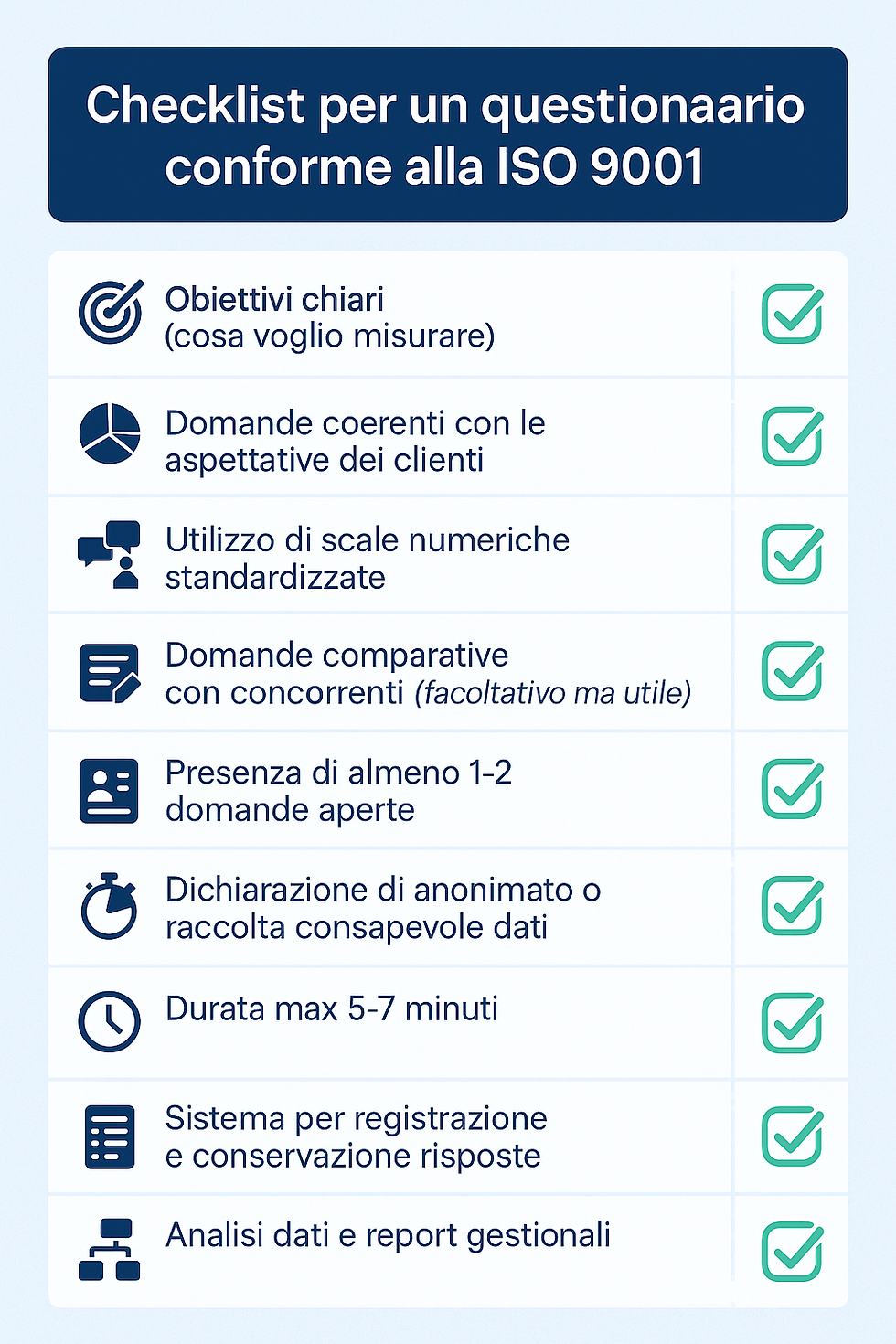ISO 9001 Customer Satisfaction Survey: Examples, Questions, and Checklists
- Redazione

- Jul 11
- 4 min read

Table of Contents
What is customer satisfaction according to ISO 9001?
ISO 9001:2015 defines a customer as any party receiving a product or service from an organization, including internal customers, users, and distributors.
Customer satisfaction is the degree of perception of whether the management system, products or services have met the customer's expectations .
It is a subjective but strategic measure: it reflects perceived quality and helps identify areas for improvement.
Why ISO 9001 requires you to measure it (section 9.1.2)
According to paragraph 9.1.2 of the standard, the organization shall monitor “information relating to customer perceptions of the degree to which their requirements have been met”.
What does this entail?
You must have at least one mechanism to collect feedback (e.g., questionnaire).
You need to measure, record, and analyze data.
You need to use the results to improve processes and services.
An ISO audit will also check whether the system is documented and used effectively.
How to measure it: recommended methods
Structured questionnaires ( online or paper)
Advantages: they are inexpensive, measurable, replicable over time.
Telephone interviews (CATI)
Advantages: They allow for insights into specific causes.
Advantages: useful for qualitative analysis, understanding the “why” behind the vote.
Analysis of complaints/feedback received
Advantages: you use data already available, to be encoded.
Indirect customer observation
Advantage for points of sale: collect opinions directly on site.
The best mix: questionnaire + some focus/selective interviews to validate the choices.
How to create an ISO 9001 compliant questionnaire
The questionnaire is the primary tool for measuring satisfaction. To make it effective and compliant, here's how to structure it.
General structuring
Title and purpose : e.g. “Customer satisfaction survey 2026 – ISO 9001”.
Clear instructions : explain completion time, anonymity, purpose.
Identifying data (if profiling is required): e.g., sector of use, type of contract.
The questionnaire is the most effective and widely used tool for measuring ISO 9001 customer satisfaction .
It is inexpensive, replicable, and allows for standardized data collection on a large scale.
But be careful: to comply with the ISO standard it must be designed methodically and uniformly.
Why does the questionnaire need to be stable over time?
The standard requires monitoring and analysis . To be able to compare data from one year to the next , the questionnaire must:
maintain the same basic structure (e.g. scales from 1 to 5 or 1 to 10),
include the same core questions year after year,
allow for the analysis of changes and comparison with objectives or benchmarks.
📊 This is what makes a questionnaire an ISO quality control tool, and not just a spot survey.
Can I compare my results with my competitors?
Yes. A good practice is to include at least one comparative question on the customer's perception of alternatives on the market , such as:
"Compared to other similar providers/products, how do you rate our service?"
This allows you to evaluate the perceived positioning of your company in relation to its direct competitors.
✅ The 20 questions that cannot be missing from a satisfaction survey
Here is an example of a structured questionnaire, which you can use as a basis (modifiable by sector).
Questions use a scale from 1 (not at all satisfied) to 5 (very satisfied), unless otherwise noted.
Area 1 – General Experience
How satisfied are you with the service/product you received?
Did our service meet your expectations?
Was the staff courteous and helpful?
How easy was it to get in touch with us?
Did you receive clear and complete information?
Area 2 – Time and reliability
Were delivery or response times met?
Was our service punctual and reliable?
How efficient do you rate the purchasing or activation process?
Area 3 – Product/service quality
How do you rate the overall quality of the product/service?
Does the product/service meet your operational or usage needs?
Have you encountered any defects or malfunctions?
Area 4 – After-sales assistance and support
How satisfied are you with the assistance you received (if requested)?
Were the issues resolved in a timely manner?
Did you receive fair treatment even if you complained?
Area 5 – Corporate image and perception
How loyal do you feel to our company?
Would you recommend our company to others? (Net Promoter Score scale 0-10)
Compared to other similar suppliers/products, how do you rate our service?
Area 6 – Open Questions
What impressed you most about our service?
What can we improve?
Would you like to add a suggestion or a free comment?
Checklist to ensure ISO compliance

How often to administer it
The ideal frequency depends on the type of company:
B2B companies with a long cycle (e.g. manufacturing): Once a year, usually in preparation for the ISO audit.
Ongoing services (e.g., hosting, consulting, support): every 6 months or upon completion of critical milestones.
Retail, commercial establishments : after the purchase or provision of the service, with an automated system.
Regularity allows you to compare results over time, evaluate the impact of corrective actions, and demonstrate monitoring from an ISO perspective.
With this structure you can:
write a questionnaire consistent with ISO 9001,
administer it on a regular basis,
and integrate the results into the quality management system, for example in the management review.
If you need help writing, administering, or analyzing it , Hangler Marketing Advisor can help with specific expertise in this type of research.



Comments